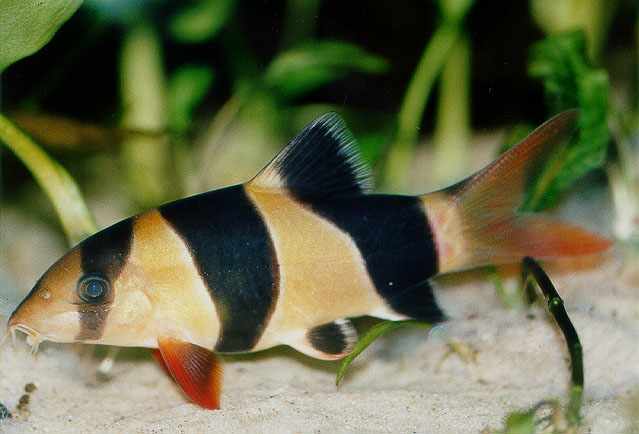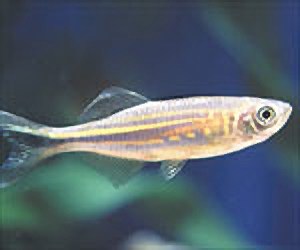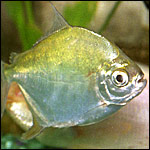
These fish like to jump so keep a good top on the aquarium or a good covering of plants. They will appreciate some floating plants but also need a clear area in which to feed. They are often sold as Silver Hatchetfish, which is actually another species, Thoracocharax securis.
| Common name | Common Hatchetfish | 
|
| Scientific name | Gasteropelecus sternicla | |
| Synonyms | Silver Hatchetfish | |
| Size | 2-3" (5-7.5cm) | |
| Origin | Brazil, Guyana | |
| Tank setup | Planted community tank, with some floating plants. A cover glass is needed, as these fish may jump. | |
| Compatibility | Peaceful, community tank | |
| Temperature | 23-26oC (73-78oF) | |
| Water chemistry | Slightly acidic (pH 6.0-7.0), soft to slightly hard. | |
| Feeding | An insectivore: mosquito larvae, small flies. Will accept dry foods. | |
| Sexing | Males are slimmer | |
| Breeding | Unknown in the aquarium | |
| Shoaling | A true top-dweller. Keep in a shoal of 5-6 or more. |
A very popular aquarium fish, both for its colour and its antics. One of its habits is to lie on its side when resting - which may alarm those not familiar with it, as the fish may appear to be ill! They may also make audible clicking sounds, particularly at feeding time. They tend to be more active if kept as a small group, rather than singly or in pairs. Provide plenty of refuges in the way of bogwood or hollow cylinders such as bamboo or pipes, as the fish like to rest out of sight.
| Common name | Clown Loach | 
|
| Scientific name | Botia macracanthus | |
| Synonyms | Clown botia, Tiger botia | |
| Size | Up to 12" (30cm), but usually smaller in aquaria - about 6" (15cm). | |
| Origin | Borneo, Sumatra, India | |
| Tank setup | Large tank with plenty of hiding places | |
| Compatibility | Peaceful, community tank | |
| Temperature | 23-30oC (73-86oF) | |
| Water chemistry | Fairly soft, slightly acidic (pH 6-7) | |
| Feeding | Omnivorous, but prefers meaty foods | |
| Sexing | Unknown, females may be fuller bodied | |
| Breeding | There have only been occasional spawnings reported in aquaria, of which there are no detailed accounts. |
The name Leporinus comes from Latin and roughly means "of a hare " this is because the shape of the upper lip is very similar to that of a hare, hence its name. This fish is bullet shaped and elongated and somewhat compressed laterally. The fish is mustard-yellow to golden-yellow with nine fairly thick black bars that run from top to bottom that sometimes split at the belly area and fade out on the underside.
| Common name | Black-Banded Leporinus | 
|
| Scientific name | Leporinus Fasciatus | |
| Synonyms | Banded Leporinus, Leporinus. | |
| Size | 12 in., 30 cm | |
| Origin | South America in the Rio de la Plata and Orinico Rivers | |
| Tank setup | Heavily Planted tank | |
| Compatibility | Can Be aggressive | |
| Temperature | 24oC (75oF) | |
| Water chemistry | Neutral pH (about 7.0) | |
| Feeding | Omnivorous, most foods accepted | |
| Sexing | There are no visible differences between the male and female | |
| Breeding | Egg layer. Rarely, if ever, bred in captivity |
Monos are very quick fish that need plenty of open swimming space. For a fully grown adult an aquarium of no less than 45 gallons will do. They prefer to swim in schools of five or more. These are shy fish that should have plenty of hiding places in the aquarium such as rocks and plants that can withstand brackish water. Although peaceful, Monos do grow to a large size and may make a meal of smaller fishes that they out-grow.
| Common name | Mono Sebae |

Mono Sebae |
| Scientific name | Monodactylus sebae | |
| Synonyms | African Mono, Malayan Angel, Mono, Fingerfish, Silver Batfish, Moonfish, Diamondfish | |
| Size | 10" | |
| Origin | East Africa, Asia | |
| Tank setup | Large tank with plenty of swimming space, but lots of hiding places as well. | |
| Compatibility | Peaceful, but they get quite large | |
| Temperature | 24oC (75oF) | |
| Water chemistry | Slight Alkaline (pH 7.2). Can live in freshwater, brackish or saltwater. | |
| Feeding | Omnivorous, most foods accepted | |
| Sexing | Cannot be easily distinguished | |
| Breeding | Extremely difficult in home aquaria. They are egg dispersers with planktonic young. |
There is some controversy surrounding the origins of this fish. Most believe it to be a hybrid of Heros severus (Severum) and a closely related species (due to the fish often being fertile), although more unlikely second species have been suggested - including the goldfish! One of the Amphilophus species is more likely. The hybridisation has resulted in a deformed body shape and small mouth. Juveniles are normally greenish in colour, but adults can be found in a range of colours from yellowish to blood red.
| Common name | Parrot | 
|
| Scientific name | No valid scientific name - not a true species, sometimes referred to as 'Cichlasoma' parrot | |
| Synonyms | Blood Parrot, Red Parrot | |
| Size | upto 6" | |
| Origin | Not found in the wild, an artificial hybrid | |
| Tank setup | A fairly large tank with rounded stones and planted areas. | |
| Compatibility | Can Be Aggressive | |
| Temperature | 75-82oF | |
| Water chemistry | Not too critical: medium hard with neutral to slightly alkaline pH (7.0-7.6) | |
| Feeding | Omnivorous, most foods accepted | |
| Sexing | ||
| Breeding | Eggs are laid on a pre-cleaned site and protected by the parents. |
The Giant Danio is an excellent fish for the larger community aquarium. A blue-green background on the fish is intensified by its gold spots and lines. Giant Danios are a very active fish requiring a large community aquarium with plenty of swimming room. A hood should be installed on the aquarium housing these fish, as they like to jump. Giant Danios should be kept in a group consisting of 5 or more fish.
| Common name | Giant Danio |

|
| Scientific name | Danio aequipinnatus | |
| Synonyms | ||
| Size | Up to 6" (15cm) | |
| Origin | India and Sri Lanka | |
| Tank setup | Planted tank with plenty of swimming space | |
| Compatibility | These fish are peaceful and will generally get along good with other fast moving tankmates. | |
| Temperature | 72-82oF | |
| Water chemistry | Hardy fish, prefer neutral pH | |
| Feeding | Giant Danios are omnivorous. They should be fed a varied diet of prepared foods such as flakes or freeze-dried tablets. | |
| Sexing | Males are more brightly colored. | |
| Breeding | These aquarium favorites will spawn only when kept in large schools. They are sexually mature at 2.5 inches. Sunlight and fine-leaved plants will encourage breeding. |
This fish is a very hardworking algae eater. Unfortunately its large size and 'clumsyness' tend to make it less suitable for small or heavily planted tanks. It is a very robust fish which will adapt to most conditions. The common name of "plec" or "pleco" is derived from the obsolete genus name of Plecostomus. A number of different species are sometimes sold under the name of 'common plec', which may include other species in addition to the two above. One of them is the Sailfin plec, Glyptoperichthys gibbiceps, but this is more easily recognizable by its larger dorsal fin and a more 'honeycomb' type pattern.
| Common name | Common plecostamus / pleco | 
|
| Scientific name | Hypostomus punctatus or Glyptoperichthys multiradiatus | |
| Synonyms | Suckermouth catfish, Plecostomus punctatus | |
| Size | H. punctatus: up to 12" (30cm), G. multiradiatus: up to 18" (45cm) | |
| Origin | South America | |
| Tank setup | Large tank, with caves or bogwood for refuges | |
| Compatibility | Generally OK for the larger community tank, may be territorial over a favourite cave. | |
| Temperature | 19-26oC (66-79oF) | |
| Water chemistry | Not critical, tolerates a wide range of pH and hardness values. | |
| Feeding | A good algae eater, this should be supplemented with algae wafers, sinking pellets, green foods. They will also consume most other foods missed by midwater dwelling fish. | |
| Sexing | No obvious differences. Adult males may be smaller than females | |
| Breeding | Unlikely in the aquarium - accomplished in outdoor ponds, where the fish dig tunnels in which to spawn. |
This very striking fish has become much sought after since its initial appearance, and still commands quite a high price tag. It has been bred in captivity, but not on a regular basis. My zebra's tend to hide alot. I rarely see them.
| Common name | Common plecostamus / pleco |

|
| Scientific name | Hypancistrus zebra | |
| Synonyms | Imperial pleco/peckoltia | |
| Size | Up to 3" (7.5cm) | |
| Origin | Brazil, Rio Xingu | |
| Tank setup | Dark rock or bogwood for refuges, preferably a sandy substrate. Very efficient filtration and good circulation. | |
| Compatibility | Peaceful. | |
| Temperature | 25-30oC (77-86oF) | |
| Water chemistry | Fairly soft to slightly hard, pH 6.5-7.4 | |
| Feeding | Omnivorous, tends to prefer meaty foods, but does eat green foods. Not really an algae eater. They will also consume most other foods missed by midwater dwelling fish. | |
| Sexing | The first ray of the pectoral fin is thicker in the male with odontodes (tiny spines) visible, these can also be observed just below the operculum (gill plate). | |
| Breeding | Maintain temperature at the upper end of the range. Spawning takes place in small caves. The male will guard his selected cave, which the female then enters. After spawning, the male fertilises and guards the eggs. It may be wise to hatch the eggs artificially, as the newly hatched fry may be eaten by the parents. Small regular water changes and good oxygenation are necessary. Feed the fry on newly hatched brine shrimp |
The elongated fin across the bottom portion of the body allows for forward and reverse movements. Most types of Knifefish usually hide inside a cave during the day and come out at night to hunt for small fish. The African Black Knife Fish is very hardy and not too aggressive, but will eat fish it can swallow.
| Common name | African Brown Knife | 
|
| Scientific name | Xenomystus nigri | |
| Synonyms | African Knife | |
| Size | 4-4 1/2 inches | |
| Origin | Africa | |
| Tank setup | Moderately decorate with live plants, rocks and driftwood. | |
| Compatibility | Peaceful with other fish, but will fight amongst themselves. | |
| Temperature | 78 oF | |
| Water chemistry | ||
| Feeding | Small live foods such as fish, blood worms, glass worms, tubifex worms and brine shrimp. Frozen plankton, beef heart, glass worms, blood worms and brine shrimp. | |
| Sexing | ||
| Breeding | Unknown. |
Silver Dollars are relatives of the Piranha. But Silver Dollars are mainly vegetarians that will adapt to eat almost anything.
| Common name | Silver Dollar | 
|
| Scientific name | Metynnis hypsauchen | |
| Synonyms | ||
| Size | 6" (15cm) | |
| Origin | South America | |
| Tank setup | Large tank with plenty of open swimming space | |
| Compatibility | Larger community fish | |
| Temperature | 75-82oF | |
| Water chemistry | Not too critical but soft, slightly acidic prefered | |
| Feeding | Accepts most foods, but diet should be mainly vegetable matter | |
| Sexing | The male can be distinguished from the female by a bit of red coloration in the anal fin. | |
| Breeding | Eggs are layed amongst clumps of plants |